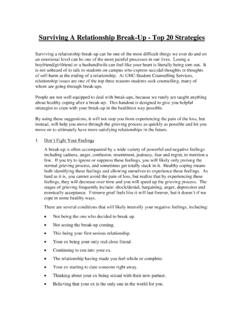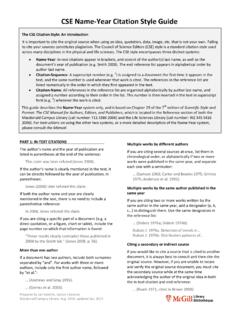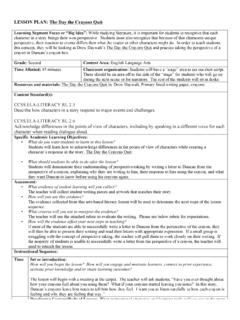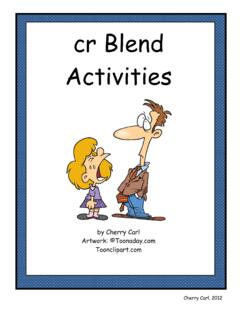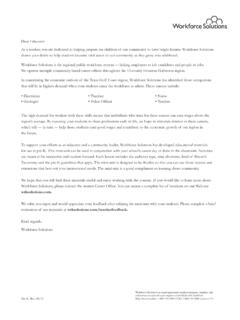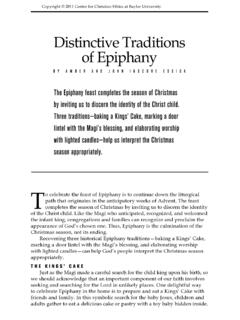Transcription of LESSON 1: COGNITIVE EMOTION REGULATION
1 LESSON 1: COGNITIVE EMOTION REGULATION Materials Required: 2 pieces of paper cut into circles per student crayons Skills to build: Awareness about emotions and about the way that our thinking can regulate our emotions Introduction to different COGNITIVE EMOTION REGULATION strategies Learning the differences between the positive and negative strategies that we use to regulate our emotions Recognizing the use of good and bad strategies in everyday situations Vocabulary to highlight/clarify: Stress: something that causes strong feelings of worry or anxiety EMOTION : a strong feeling like excitement or anger EMOTION REGULATION : being able to properly control our emotions .
2 Consequences: the result of an action Strategy: a method used to achieve a goal NOTE: Throughout all classes it is important to constantly engage the students by asking them to provide examples and participate in discussion. Filling out the worksheets should not be silent, individual work. They should be completed as a class with each student providing their own personal examples. LESSON PLAN PART 1: Highlight to the class that life is full of stressful experiences. We have different ways to deal with the stressors in our lives. One way is by managing the emotions that we feel in relation to these stressors.
3 One of the ways that we deal with stressful experiences is to manage the emotions that we feel in relations to these stressors. This means that we try to control our emotions . Can anyone give me an example of a stressful experience that they have had? What emotions did this experience make you feel? o ex: Regulating our emotions is complex and it involves having control over different things: o The way that we experience our emotions o The way that we think about our reactions to the stressful experience. We want to understand how we think about our emotions so that we can control them and change them o The feeling we get in our body after experiencing stressors Ex: heart rate, breathing, etc.
4 O Our behavior Ex: our actions or facial expressions when we feel an EMOTION We can control our emotions if they are positive or negative o Can anyone give me an example of a positive and a negative EMOTION ? o Ex: The way that we control our emotions can also have positive or negative consequences o Ex: When we control our emotions in a good way, we feel better about ourselves (increased self-esteem) and about the future (optimism) PART 2: What are you doing here? What is this class about? What are we going to learn from these lessons? Why is it so important? Controlling our emotions is something you can do with different strategies.
5 There are 9 different strategies that you can use; 5 of these are positive ones. o We are going to learn the 9 different strategies and how they help us control our emotions o That will help us change the way we think about stressful event and it will help us control our emotions in a positive way. o Learning how to do this will allow us to control our emotions in a positive way and get along better with one another. PART 3: COGNITIVE EMOTION - REGULATION is a COPING STRATEGY What do I mean when I say I want to give you a strategy ? Does anyone know what a strategy is? A strategy is a method that you use to achieve a goal.
6 It can take time and practice to develop o in basketball, to improve your shots you need to practice shooting hoops every day. The more and more you go to the gym and practice this skill, the better you will get and eventually you will be shooting perfect hoops after the other! Remember though, it takes practice to learn how to use our strategies more effectively and to control our emotions Being able to use positive strategies to control your emotions does not depend on your age you may think adults all know how to control their emotions , but this is not the case. Kids don t always use negative strategies and adults don t always use positive strategies Everyone can benefit from getting learning how to think about their emotions and practice using positive strategies to help us keep our emotions under control.
7 PART 4: CLASSROOM EXAMPLE WITH STUDENT PARTICIPATION Let s practice thinking about stressful experiences that can make us feel and think negatively. Ex: When Suzy was 9 she got a hamster for her birthday. She called her hamster Bubbles and she loved him a lot. Last week, 4 years later, her hamster died. She was really sad and wouldn t leave her room for days. o What was the stressful event in this story? o How did it make Suzy feel? o What thoughts did Suzy have? Were they positive and happy thought? Were they negative and unhappy thoughts? o What could Suzy do to make herself feel better?
8 Can she change her mind and think happier thoughts? PART 5: WORKSHEET ACTIVITY Let s practice recognizing different experiences and emotions that we have. 1. First I would like you to draw something for me. Give each child two paper circles and a crayon. Demonstrate how to draw a happy face on one circle, and an angry face on the other. 1. On the first piece of paper I would like you to draw a happy face. Like this (point to happy face drawn on the board). 2. On the second piece of paper I would like you to draw a sad face. Like this (point to the sad face drawn on the board). 2. React: Each time you describe a situation, ask children to hold up the appropriate face to show how they would feel.
9 Here are some examples: How would you feel if your best friend invited you to a party? How would you feel if no one would let you use the swing? How would you feel if you and your friends built a beautiful sandcastle together? How would you feel if some kids started teasing you by saying you were a baby? How would you feel if you went to the park with your family on a beautiful sunny day? How would you feel if you feel down and hurt your knee? How would you feel if you got to eat the best cake in the world on your birthday? How would you feel if you got into trouble because your friends told the teacher that you did something wrong?
10 LESSON 2: ACCEPTANCE Materials Required: Computer with internet Skill to build: Understand the concept of acceptance Learn how to apply the strategy of acceptance to various situations Vocabulary to highlight/clarify: Acceptance: coping with an experience by accepting it and moving on Cope: to deal with a situation successfully Anxiety: nervousness about what might happen Consequences: the result of an action Strategy: a method used to achieve a goal RECAP and GOALS OF CURRENT CLASS: Last classes we talked about how life is full of stressful situation that make us feel different negative emotions .
